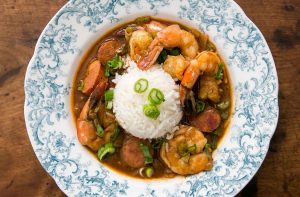Gumbo is a beloved staple of the South, and its seafood variety is perhaps the most traditional. While there are as many gumbo recipes as there are cooks, the stock is a critical foundation that can make or break this dish. This seafood gumbo stock recipe uses shrimp shells for a deep, rich flavor that will truly elevate your gumbo.

This recipe calls for shrimp shells, which may not be commonly found in your kitchen. Fear not! You can often find shrimp shells at a seafood market or sometimes in the frozen seafood section of your supermarket. They are often inexpensive or even free, as they are typically the byproduct of shelling shrimp for other uses.
Ingredients for Seafood Gumbo Stock
Shrimp shells: These give our stock a deep, rich flavor that is unmistakably seafood. No gumbo is complete without it.
Carrots: The sweetness of carrots helps balance the salty seafood flavor.
Onions: Onions are a base flavor in almost all stocks and add a necessary savory note.
Celery: Celery adds a fresh flavor and is part of the classic trio in Cajun and Creole cooking, along with onions and bell peppers.
Bay leaves: These add a subtle depth and complexity to the stock.
Garlic: The pungent flavor of garlic is a must in gumbo, bringing a bit of heat and lots of flavor.
Parsley: This adds a slight bitter note, helping to balance out the other flavors.
Cloves: Cloves add a bit of warmth and spice to our stock.
Pepper: For a hint of heat.
Basil: Basil brings a fresh and slightly sweet flavor.
Thyme: Thyme adds a subtle, earthy flavor that complements the other ingredients wonderfully.
One reader, Fitzgerald Washington says:





This seafood gumbo stock recipe is a game-changer! The flavors are rich and authentic, and the stock adds a depth of flavor to my gumbo that's simply unbeatable. It's a must-try for any seafood lover. I highly recommend it for anyone looking to elevate their gumbo game!
Key Techniques for Crafting Seafood Gumbo Stock
How to prepare the shrimp shells: Bake the shrimp shells at 375 degrees F until dried and starting to brown on the edges.
How to make the stock: In an 8-quart pot, combine the water, carrots, onions, celery, bay leaves, garlic, parsley, cloves, pepper, basil, thyme, and shrimp shells. Bring slowly to a boil, reduce the heat, and cook for 5 to 7 hours. Replace the water as needed, 2 or 3 times, by pouring more water down the inside of the pot.
How to strain the stock: Remove the stock from the heat, and strain. Press all the liquid from the shells and vegetables, then discard them.
How to reduce the stock: Return the liquid to the heat, and reduce to 2 to 3 quarts, or to taste.
How To Make Seafood Gumbo Stock
Level up your gumbos with his notably savory and rich gumbo stock, made with shrimp shells, veggies, and spices boiled for hours for full flavor.
Serves:
Ingredients
- 1lbshrimp shells
- 20cupswater
- 4carrots,sliced
- 4onions,quartered
- ½bunchcelery,sliced
- 2bay leaves
- 3garlic cloves,sliced
- 2fresh parsley sprigs
- 5whole cloves
- 1tspground black pepper
- 1tbspdried basil
- 2tspdried thyme
Instructions
-
Bake the shrimp shells at 375 degrees F until dried and starting to brown on the edges.
-
In an 8-quart pot, combine the water, carrots, onions, celery, bay leaves, garlic, parsley, cloves, pepper, basil, thyme, and shrimp shells.
-
Bring slowly to a boil. Reduce the heat, and cook for 5 to 7 hours. Replace the water as needed, 2 or 3 times, by pouring more water down the inside of the pot.
-
Remove the stock from the heat, and strain. Press all the liquid from the shells and vegetables, then discard them.
-
Return the liquid to the heat, and reduce to 2 to 3 quarts, or to taste.
-
Use in gumbo recipes, and enjoy!
Nutrition
- Calories: 83.88kcal
- Fat: 0.80g
- Saturated Fat: 0.21g
- Trans Fat: 0.01g
- Monounsaturated Fat: 0.13g
- Polyunsaturated Fat: 0.24g
- Carbohydrates: 10.60g
- Fiber: 2.44g
- Sugar: 4.26g
- Protein: 8.97g
- Cholesterol: 71.44mg
- Sodium: 377.18mg
- Calcium: 92.94mg
- Potassium: 299.33mg
- Iron: 1.04mg
- Vitamin A: 289.67µg
- Vitamin C: 7.62mg
Pro Tip for Perfecting Your Seafood Gumbo Stock
When making your seafood gumbo stock, it's important to remember that the longer you simmer the stock, the more flavorful it will be. However, be careful not to let it boil vigorously as this can make the stock cloudy. A gentle simmer is all that's needed to extract the flavors from the shrimp shells and vegetables. Additionally, roasting the shrimp shells before adding them to the pot can deepen the flavor of your stock. Lastly, when straining the stock, be sure to press the shells and vegetables to extract as much liquid and flavor as possible.
Time-Saving Tips for Preparing Seafood Gumbo Stock
Prep ahead: Chop and measure all ingredients in advance to streamline the cooking process.
One-pot wonders: Opt for recipes that allow you to cook everything in a single pot or pan to minimize cleanup.
Use kitchen tools: Utilize kitchen tools like food processors and mandolines to speed up the prep work.
Freeze ahead: Make a double batch of the gumbo stock and freeze the extra for future use.
Organize your workspace: Keep your kitchen organized and clean as you cook to avoid wasting time searching for ingredients and utensils.
Substitute Ingredients For Seafood Gumbo Stock Recipe
shrimp shells - Substitute with crab shells: Crab shells can provide a similar depth of flavor and richness to the stock, adding a delicious seafood taste.
water - Substitute with vegetable broth: Vegetable broth can add a savory and aromatic flavor to the gumbo stock, enhancing the overall taste.
carrots - Substitute with bell peppers: Bell peppers can contribute a slightly sweet and earthy flavor, complementing the other ingredients in the gumbo stock.
onions - Substitute with leeks: Leeks can offer a milder and slightly sweeter flavor, adding complexity to the stock.
celery - Substitute with fennel: Fennel can provide a subtle anise-like flavor, enhancing the aromatic profile of the gumbo stock.
bay leaves - Substitute with dried thyme: Dried thyme can add a similar earthy and slightly floral note to the stock, enhancing its overall flavor profile.
garlic cloves - Substitute with shallots: Shallots can offer a milder and slightly sweeter flavor, adding depth to the gumbo stock.
parsley sprigs - Substitute with cilantro: Cilantro can provide a fresh and herbaceous flavor, adding a vibrant touch to the gumbo stock.
cloves - Substitute with allspice: Allspice can offer a similar warm and aromatic flavor, adding depth to the gumbo stock.
dried basil - Substitute with dried oregano: Dried oregano can provide a similar herbaceous and slightly peppery flavor, enhancing the overall taste of the gumbo stock.
Presenting Your Seafood Gumbo Stock
Elevate the seafood gumbo stock: Start by serving the seafood gumbo stock in a sophisticated and elegant vessel, such as a classic porcelain tureen or a modern glass bowl. This will showcase the rich color and depth of the stock, setting the stage for the exquisite flavors to come.
Garnish with fresh herbs: Sprinkle a generous amount of freshly chopped parsley and thyme over the top of the gumbo stock. The vibrant green hues will add a pop of color and a burst of freshness to the dish, enhancing its visual appeal.
Accompany with crusty artisan bread: Serve the seafood gumbo stock alongside slices of warm, crusty artisan bread. This will provide a delightful textural contrast and allow guests to savor every last drop of the flavorful stock.
Present with a seafood medley: For an extra touch of elegance, consider adding a small selection of seafood such as succulent shrimp or delicate crab meat to the center of the stock. This not only adds visual interest but also hints at the delightful seafood flavors within.
Use fine dining plating techniques: Employ meticulous plating techniques, such as carefully wiping the rim of the serving vessel to ensure a pristine presentation. Attention to detail is key in showcasing the gourmet quality of the seafood gumbo stock.
Offer a side of aromatic rice: Serve a side dish of fragrant aromatic rice alongside the seafood gumbo stock. This allows guests to customize their dining experience by adding a spoonful of rice to their stock, creating a harmonious blend of flavors and textures.
Enhance with a drizzle of quality olive oil: Just before serving, delicately drizzle a small amount of premium olive oil over the top of the seafood gumbo stock. This adds a luxurious sheen and a hint of fruity richness, elevating the overall presentation.
Essential Tools for Making Seafood Gumbo Stock
- Cutting board: A flat board used for cutting and preparing ingredients.
- Chef's knife: A versatile knife used for chopping, slicing, and dicing.
- Stockpot: A large pot used for making stocks, soups, and stews.
- Strainer: A tool used to separate solids from liquids, often used for straining stocks.
- Measuring cups and spoons: Used to measure precise amounts of ingredients.
- Wooden spoon: A sturdy spoon made of wood, used for stirring and mixing ingredients.
- Baking sheet: A flat, rectangular metal pan used for baking and roasting.
- Oven: A kitchen appliance used for baking, roasting, and heating food.
- Saucepan: A small, deep pan used for heating and cooking sauces and liquids.
- Tongs: A utensil with two arms and a pivot used for gripping and lifting items.
- Oven mitts: Insulated gloves used to protect hands when handling hot dishes and cookware.
- Aluminum foil: A thin, pliable sheet of aluminum used for covering dishes and wrapping food for cooking.
- Stove: A cooking appliance with burners used for heating and cooking food.
- Meat thermometer: A tool used to measure the internal temperature of meat and poultry to ensure it is cooked safely.
- Skimmer: A utensil with a perforated bowl used for removing foam or impurities from liquids.
- Cheesecloth: A loose-woven cotton cloth used for straining liquids and making sachets of herbs and spices.
- Garlic press: A tool used to crush and mince garlic cloves.
- Ladle: A long-handled spoon with a deep bowl used for serving soups, stews, and sauces.
Storing and Freezing Seafood Gumbo Stock
Once the seafood gumbo stock has cooled to room temperature, transfer it to an airtight container or a large glass jar. Make sure to leave about an inch of headspace at the top to allow for expansion during freezing.
Label the container with the date and the contents, so you can easily keep track of when the stock was made and how long it has been stored.
Place the container in the refrigerator if you plan to use the stock within 3-4 days. The gumbo stock will stay fresh in the fridge for up to a week.
If you want to store the stock for a longer period, transfer it to the freezer. The stock can be frozen for up to 6 months without losing its flavor or quality.
Consider freezing the stock in smaller portions, such as in ice cube trays or small freezer bags, so you can easily thaw only the amount you need for a specific recipe. Once frozen, transfer the stock cubes to a larger freezer bag for compact storage.
To thaw the frozen gumbo stock, place it in the refrigerator overnight or for several hours until it has completely thawed. Alternatively, you can thaw the stock in the microwave using the defrost setting, stirring occasionally to ensure even thawing.
Once thawed, use the stock within 2-3 days and do not refreeze it to maintain the best quality and flavor.
Always smell and taste the stock before using it to ensure it hasn't spoiled. If the stock has an off odor, flavor, or appearance, discard it immediately.
How To Reheat Leftover Seafood Gumbo Stock
To reheat leftover seafood gumbo stock, start by transferring the desired amount into a saucepan or pot. Avoid using the microwave, as it can cause the delicate flavors to dissipate and the texture to become uneven.
Place the saucepan on the stove over medium-low heat. Stir the stock gently and continuously to ensure even heating throughout. This method allows the flavors to meld together once again and prevents any ingredients from sticking to the bottom of the pan.
If you find that the stock has thickened considerably during storage, you can add a small amount of water or seafood stock to thin it out. Be cautious not to add too much liquid, as it can dilute the rich flavors you worked so hard to develop.
As the stock heats up, you may notice a layer of fat rising to the surface. Use a spoon to skim off this excess fat, which will help to clarify the stock and improve its overall taste and appearance.
Continue heating the gumbo stock until it reaches a gentle simmer. Allow it to simmer for a few minutes, ensuring that it is heated through evenly. Avoid bringing the stock to a rapid boil, as this can cause the flavors to become muted and the ingredients to break down.
Once the stock is heated to your desired temperature, taste it and adjust the seasoning if necessary. You may find that the flavors have intensified during storage, so a little extra salt, pepper, or your favorite Cajun seasoning blend can help to balance things out.
Serve the reheated seafood gumbo stock as a base for your favorite gumbo recipe, or enjoy it on its own as a comforting and flavorful soup. Garnish with fresh parsley, green onions, or a sprinkle of file powder for an authentic Louisiana touch.
Interesting Trivia About Seafood Gumbo Stock
The seafood gumbo stock recipe is a traditional Creole and Cajun dish that originated in Louisiana. It is a flavorful and hearty stew that typically includes a variety of seafood such as shrimp, crab, and oysters, as well as vegetables and spices. Gumbo is often served over rice and is a popular dish for special occasions and gatherings. It is a delicious and comforting meal that has been enjoyed for generations in the southern United States.
The Economics of Homemade Seafood Gumbo Stock
This seafood gumbo stock recipe is quite cost-effective for a household. The use of shrimp shells and common vegetables makes it budget-friendly. The stock can be used as a base for various seafood dishes, adding value to the investment. Considering the versatility and flavor enhancement it provides, I would rate this recipe an 8/10 for cost-effectiveness. The approximate cost for a household of 4 people would be around $10-$15, making it an affordable option for enhancing the flavor of various seafood dishes.
Is Seafood Gumbo Stock Recipe Healthy?
The seafood gumbo stock recipe is relatively healthy, as it primarily consists of vegetables, herbs, and shrimp shells. The ingredients provide a variety of nutrients, such as vitamins A and C from the carrots and celery, and minerals like calcium and magnesium from the shrimp shells. The recipe is also low in fat and calories, as it does not include any added oils or high-calorie ingredients.
However, there are a few aspects that could be improved to make the recipe even healthier:
- Reduce the cooking time to preserve more of the nutrients in the vegetables
- Use organic vegetables and herbs to minimize exposure to pesticides and other chemicals
- Consider adding other nutrient-dense ingredients, such as seaweed or mushrooms, to boost the nutritional value of the stock
To further enhance the health benefits of this seafood gumbo stock recipe, you could:
- Add a tablespoon of apple cider vinegar to help extract more minerals from the shrimp shells
- Include a piece of kombu seaweed to provide additional minerals and umami flavor
- Incorporate a variety of mushrooms, such as shiitake or oyster mushrooms, to add depth of flavor and boost the immune-supporting properties of the stock
- Experiment with adding other herbs and spices, like turmeric or ginger, which have anti-inflammatory and antioxidant properties
Editor's Take on This Seafood Gumbo Stock Recipe
The seafood gumbo stock recipe is a classic and flavorful base for any seafood gumbo. The use of shrimp shells and a variety of aromatic vegetables and herbs creates a rich and robust stock that will infuse your gumbo with layers of delicious flavors. The slow cooking process allows the ingredients to meld together, resulting in a stock that is both hearty and aromatic. This stock is a perfect foundation for creating a truly authentic and mouthwatering seafood gumbo.
Enhance Your Seafood Gumbo Stock Recipe with These Unique Side Dishes:
Similar Recipes to Try
Appetizer and Dessert Pairings for Seafood Gumbo Stock
Why trust this Seafood Gumbo Stock Recipe:
This seafood gumbo stock recipe is a testament to authenticity and flavor. The use of shrimp shells as a base infuses the stock with rich, briny essence. The combination of carrots, onions, and celery provides a robust vegetable foundation, while the inclusion of bay leaves, garlic, and a blend of aromatic spices elevates the complexity. The slow simmering process allows the flavors to meld, resulting in a stock that embodies depth and character. Trust in the quality of this recipe, as it promises to deliver a stock that will undoubtedly enhance any gumbo or seafood dish with its unparalleled taste.
Was this page helpful?
Have your own special recipe to share? Submit Your Recipe Today!













